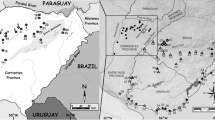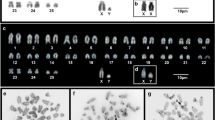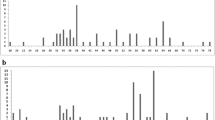Abstract
Homologous segments identified by G-banding sequences of chromosomes of Peromyscus boylii, Neotoma micropus, Oryzomys capito, (Family Cricetidae) Rattus norvegicus, Melomys burtoni, and Apodemus sylvaticus (Family Muridae) were used to hypothesize a chromosomal condition for the cricetid ancestor. A critical assumption in proposing the primitive G-banding sequences for a given chromosome is that if the outgroup and ingroup taxa have a specific sequence, then the ancestor of the ingroup taxa also had that same sequence. Using this methodology, (chromosome numbers refer to proposed homology to the standardized karyotype for Peromyscus), we propose that: (1) the primitive banding pattern of chromosome 1 was identical to that of Neotoma; (2) the primitive patterns of chromosomes 2, 3, 4, 6, 7, 8, 9, 10, 11, and 12 were primitive banding patterns of 5 and 13 were undetermined; (4) a major portion of the banding patterns of 14 and X were present in the ancestral karyotype. Only the largest 14 autosomes and X were examined because the smaller elements had insufficient G-band definition to ensure reasonable accuracy. The karyotype ancestral to that of Peromyscus, Neotoma, and Oryzomys may be as above and the banding patterns of 5, 13, and 14 were acrocentric and identical to those shown for Peromyscus, Neotoma, and Oryzomys (Fig. 1). In the primitive karyotype, heterochromatin (C-band material) was probably limited to the centromeric regions. If the primitive karyotype is as described above, then it is possible to determine the direction, type, and magnitude of chromosomal evolution evident in the various cricetid lineages. Based on the available data, radiation from the ancestral cytotype is characterized by a nonrandom distribution of types of chromosomal changes. Within many genera, more rearrangements occur in the 14 largest autosomal chromosomes of some congeneric species than distinguish the proposed primitive conditions for the genera Peromyscus, Neotoma, and Oryzomys. It would appear that the extensive morphological radiation from the primitive cricetid ancestor as indicated by the presence of over 100 surviving genera within the family, was not accompanied by extensive karyotypic changes. The magnitude of chromosomal variation that accompanies speciation in these genera appears to range from no detectable chromosomal evolution to a radical reorganization of the genome.
Similar content being viewed by others
References
Anderson, S., 1967. Introduction to the rodents, pp. 206–209. In: S., Anderson & J. K., JonesJr. (eds), Recent mammals of the world. Ronald Press, New York.
Arrighi, F. E., Stock, A. D. & Pathak, S., 1976. Chromosomes of Peromyseus (Rodentia, Cricetidae). V. Evidence of pericentric inversions. Chromosomes Today 5: 323–329.
Baker, R. J. & Barnett, R. K., 1981. Karyotypic orthoselection for addtions of heterochromatic short arms in grasshopper mice (Onychomys: Cricetidae). SWest. Nat. 16: 125–131.
Baker, R. J. & Mascarello, J. T., 1969. Karyotypic analyses of the genus Neotoma (Cricetidae, Rodentla). Cytogenetics 8: 187–198.
Baker, R. J., Barnett, R. K. & Greenbaum, I. F., 1979. Chromosomal evolution in grasshopper mice (Onychomys, Cricetidae). J. Mammal. 60: 297–306.
Baker, R. J., Haiduk, M. W., Robbins, L. W., Cadena, A. & Koop, B. F., 1982. Chromosomal studies of South American bats and their systematic implication. In: M. A. Mares & H. H. Genoways (eds), Mammalian Biology in South America. Spec. Publ. Ser. Pymatuning Lab. Ecol., Vol. VI: 303–327.
Baker, R. J., Koop, B. F. & Haiduk, M. W., 1983a. Resolving systematic relationships with G-bands: A study of five genera of South American cricetine rodents. Syst. Zool. 32: 403–416.
Baker, R. J., Robbins, L. W., Stangl, F. B.Jr. & Birney, E. C., 1983b. Chromosomal evidence for a major subdivision in Peromyscus leucopus. J. Mammal. 64: 356–359.
Baverstock, P. R., Watts, C. H. S., Adams, M. & Gelder, M., 1980. Chromosomal and electrophoretic studies of Australian Melomys (Rodentia: Muridae). Aust. J. Zool. 28: 553–574.
Baverstock, P. R., Watts, C. H. S., Gelder, M. & Jahnke, A., 1983. G-banding homologies of some Australian rodents. Genetica 60: 105–117.
Bengstsson, B. O., 1980. Rates of karyotypic evolutionin placental mammals. Hereditas 92: 37–48.
Bickham, J. W. & Baker, R. J., 1979. Canalization model of chromosomal evolution. pp. 70–84. In: J. H. Schwartz and H. G. Rollins (eds), Models and methodologies in evolutionary theory. Bull. Carnegie Mus. nat. Hist. 13: 70–84.
Bush, G. L., Case, S. M., Wilson, A. C. & Patton, J. L., 1977. Rapid speciation and chromosomal evolution in mammals. Proc. natn. Acad. Sci. USA 74: 3942–3946.
Carleton, M. D., 1980. Phylogenetic relationships in the neotomine-peromyscine rodents (Muroidea) and a reappraisal of the dichotomy within New World Cricetinae. Misc. Publs Mus. Zool. Univ. Mich. No. 157, vii+146 pp.
Committee for Standardization of Chromosomes of Peromyscus, 1977. Standardized karyotype of deer mice, Peromyscus (Rodentia). Cytogenet. Cell Genet. 19: 38–43.
Elder, F. F. B., 1980. Tandem fusion, centric fusion, and chromosomal evolution in the cotton rats, genus Sigmodon. Cytogenet. Cell Genet. 26: 199–210.
Engstrom, M. D. & Bickham, J. W., 1982. Chromosome banding and phylogenetics of the golden mouse. Ochrotomys nutalli. Genetica 59: 119–126
Gardner, A. L. & Patton, J. L., 1976. Karyotypie variation in oryzomine rodents (Cricetidae) with comments on chromosomal evolution in the neotropical cricetine complex. Occ. Pap. Mus. Zool. La St. Univ. 49: 1–48.
Greenbaum, I. F. & Baker, R. J., 1976. Determination of the primitive karyotype for Peromyseus. J. Mammal. 59: 820–834.
Greenbaum, I. F., Baker, R. J. & Bowers, J. H., 1978a. Chromosomal homology and divergence between sibling species of deer mice: Peromyscus maniculatus and P. melanotis (Rodentia: Cricetidae). Evolution 32: 334–341.
Greenbaum, I. F., Baker, R. J. & Ramsey, P. R., 1978b. Chromosomal evolution and its implications concerning the mode of speciation in three species of deer mice of the genus Peromyscus. Evolution 32: 646–654.
Haiduk, M. W., Bickham, J. W. & Schmidly, D. J., 1979. Karyotypes of six species of Oryzomys from Mexico and Central America. J. Mammal. 60: 610–615.
Hedrick, P. W., 1981. The establishment of chromosomal variants. Evolution 35: 322–332.
Koop, B. F., Baker, R. J. & Genoways, H. H., 1983. Numerous chromosomal polymorphisms in a natural population of rice rats (Oryzomys: Cricetidae). Cytogenet. Cell Genet. 35: 131–135.
Lande, R., 1979. Effective deme sizes during long-term evolution estimated from rates of chromosomal rearrangement. Evolution 33: 234–251.
Maia, V. & Hulak, A., 1981. Robertsonian polymorphism in chromosomes of Oryzomys subflavus (Rodentia: Cricetidae). Cytogenet. Cell Genet. 31: 33–39.
Mascarello, J. T. & Hsu, T. C., 1976. Chromosome evolution in woodrats, genus Neotoma (Rodentia: Cricetidae). Evolution 30: 152–169.
Mascarello, J. T. & Warner, J. W., 1974. Chromosome variation in the plains woodrat: a pericentric inversion involving constitutive heterochromatin. Experientia 30: 90–91.
Mascarello, J. T., Stock, A. D. & Pathak, S., 1974a. Conservatism in the arrangement of genetic material in rodents. J. Mammal. 55: 695–704.
Mascarello, J. T., Warner, J. W. & Baker, R. J., 1974b. A chromosome banding analysis of the mechanism involved in the karyological divergence of Neotoma phenax (Merriam) and Neotoma micropus (Baird). J. Mammal. 55: 831–834.
Pathak, S., Hsu, T. C. & Arrighi, F. E., 1973. Chromosomes of Peromyscus (Rodentia, Cricetidae). IV. The role of heterochromatin in karyotypic evolution. Cytogenet. Cell Genet. 12: 315–326.
Robbins, L. W. & Baker, R. J., 1980. G- and C-band studies on the primitive karyotype for Reithrodontomys. J. Mammal. 61: 708–714.
Robbins, L. W. & Baker, R. J., 1981. An assessment of the nature of chromosomal rearrangements in 18 species of Peromyscus (Rodentia: Cricetidae). Cytogenet. Cell Genet. 31: 194–202.
Seabright, M., 1971. A rapid banding technique for human chromosomes. Lancet ii: 971–972.
Stefos, K. & Arrighi, F. E., 1971. Heterochromatic nature of the W chromosome in birds. Expl Cell Res. 68: 228–231.
Stock, A. & Hsu, T. C., 1973. Evolutionary conservatism in arrangement of genetic material. Chromosoma 43: 211–224.
Templeton, A. R., 1980. Modes of speciation and inferences based on genic distances. Evolution 34: 719–729.
Wilson, A. C., Bush, G. L., Case, S. M. & King, M. C., 1975. Social structuring of mammalian populations and rate of chromosomal evolution. Proc. natn. Acad. Sci. USA 72: 5061–5065.
Wilson, A. C., Sarich, V. M. & Maxson, L. R., 1974. The importance of gene rearrangement in evolution: evidence from studies on rates of chromosome, protein, and anatomical evolution. Proc. natn. Acad. Sci. USA 71: 3028–3030.
Wilson, A. C., White, T. J., Carlson, S. S. & Cherry, L. M., 1977. Molecular evolution and cytogenetic evolution. pp. 375–383. In: R. S., Sparkes, D. E., Comings & C. F., Fox (eds). Molecular Human Cytogenetics: ICN-UCLA Symposium on Molecular and Cellular Biology. Academic Press, N. Y.
White, M. J. D., 1975. Chromosomal repatterning regularities and restrictions. Genetics 79: 63–72.
White, M. J. D., 1978. Modes of speciation. W. R. Freeman and Company, San Francisco, 455 pp.
Wood, A. E., 1955. A revised classification of the rodents. J. Mammal. 36: 165–187.
Yates, T. L., Baker, R. J. & Barnett, R. K., 1978. Phylogenetic analysis of karyological variation in three species of peremyscine rodents. Syst. Zool. 18: 40–48.
Author information
Authors and Affiliations
Rights and permissions
About this article
Cite this article
Koop, B.F., Baker, R.J., Haiduk, M.W. et al. Cladistical analysis of primitive G-band sequences for the karyotype of the ancestor of the Cricetidae complex of rodents. Genetica 64, 199–208 (1984). https://doi.org/10.1007/BF00115344
Received:
Accepted:
Issue Date:
DOI: https://doi.org/10.1007/BF00115344




